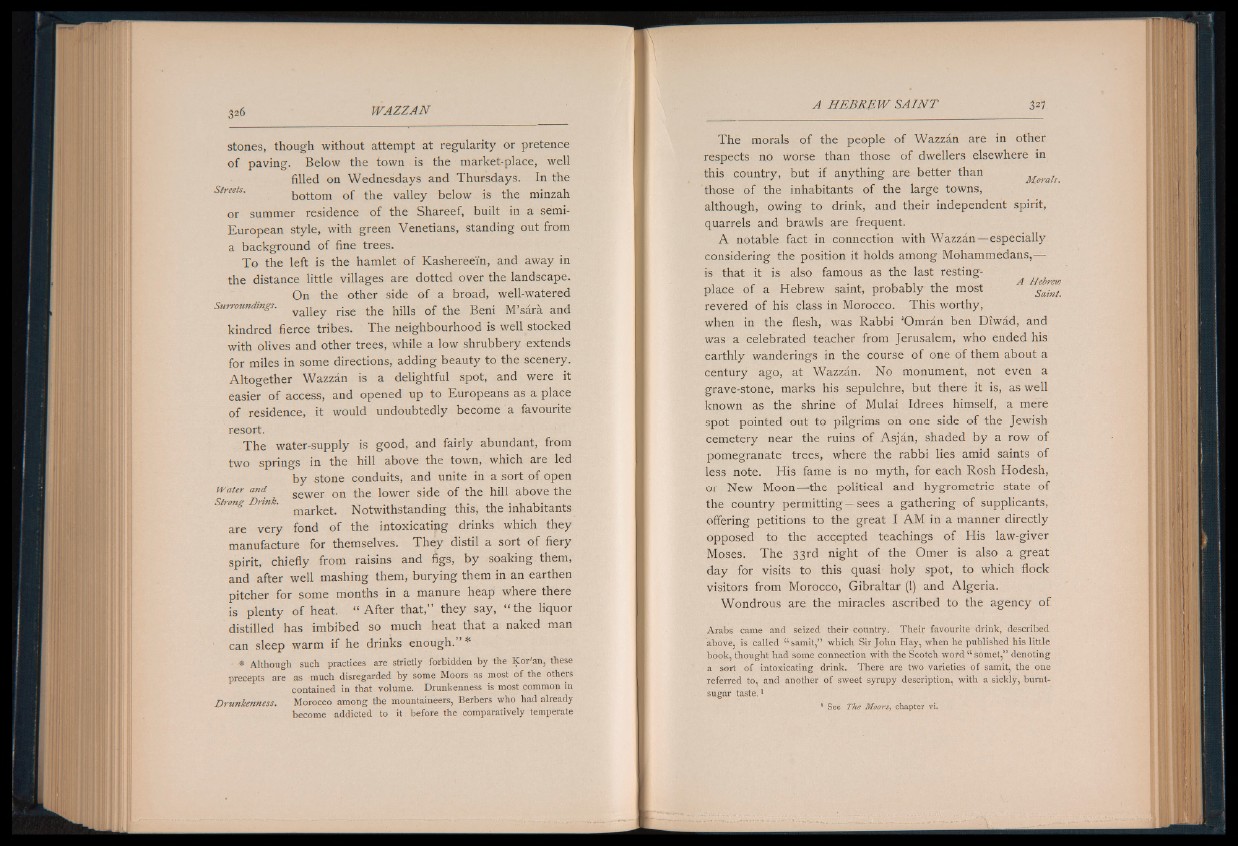
stones, though without attempt at regularity or pretence
of paving. Below the town is the market-place, well
filled on Wednesdays and Thursdays. In the
Slrrets bottom of the valley below is the minzah
or summer residence of the Shareef, built in a semi-
European style, with green Venetians, standing out from
a background of fine trees.
To the left is the hamlet o f Kashereei'n, and away in
the distance little villages are dotted over the landscape.
On the other side of a broad, well-watered
Surroundings. ^ ^ hm | of the Beni M’s£^ and
kindred fierce tribes. The neighbourhood is well stocked
with olives and other trees, while a low shrubbery extends
for miles in some directions, adding beauty to the scenery.
Altogether Wazzan is a delightful spot, and were it
easier of access, and opened up to Europeans as a place
of residence, it would undoubtedly become a favourite
resort.
The water-supply is good, and fairly abundant, from
two springs in the hill above the town, which are led
by stone conduits, and unite in a sort of open
Water and sewer on the lower side of the hill above the
Strong n . Notwithstanding this, the inhabitants
are very fond of the intoxicating drinks which they
manufacture for themselves. They distil a sort of fiery
spirit, chiefly from raisins and figs, by soaking them,
and after well mashing them, burying them in an earthen
pitcher for some months in a manure heap where there
is plenty of heat. “ After that,” they say, “ the liquor
distilled has imbibed so much heat that a naked man
can sleep warm if he drinks enough. ’ *
* Although such practices are strictly forbidden by the Kor'an, these
precepts are as much disregarded by some Moors as most of the others
contained in that volume. Drunkenness is most common in
Drunkenness. Morocco among the mountaineers, Berbers who had already
become addicted to it before the comparatively temperate
The morals of the people of Wazzan are in other
respects no worse than those of dwellers elsewhere in
this country, but if anything are better than Morals
those of the inhabitants of the large towns,
although, owing to drink, and their independent spirit,
quarrels and brawls are frequent.
A notable fact in connection with Wazzan— especially
considering the position it holds among Mohammedans,—
is that it is also famous as the last resting-
place of a Hebrew saint, probably the most Sain(
revered of his class in Morocco. This worthy,
when in the flesh, was Rabbi ‘Omrân ben Diwad, and
was a celebrated teacher from Jerusalem, who ended his
earthly wanderings in the course o f one of them about a
century ago, at Wazzan. No monument, not even a
grave-stone, marks his sepulchre, but there it is, as well
known as the shrine of Mulai Idrees himself, a mere
spot pointed out to pilgrims on one side of the Jewish
cemetery near the ruins of Asjân, shaded by a row of
pomegranate trees, where the rabbi lies amid saints of
less note. His fame is no myth, for each Rosh Hodesh,
or New Moon— the political and hygrométrie state of
the country permitting—sees a gathering of supplicants,
offering petitions to the great I AM in a manner directly
opposed to the accepted teachings of His law-giver
Moses. The 33 rd night of the Omer is also a great
day for visits to this quasi holy spot, to which flock
visitors from Morocco, Gibraltar (1) and Algeria.
Wondrous are the miracles ascribed to the agency of
Arabs came and seized their country. Their favourite drink, described
above, is called “ samit,” which Sir John Hay, when he published his little
book, thought had some connection with the Scotch word * somet,” denoting
a sort of intoxicating drink. There are two varieties of samit, the one
referred to, and another of sweet syrupy description, with a sickly, bumt-
sugar taste.1